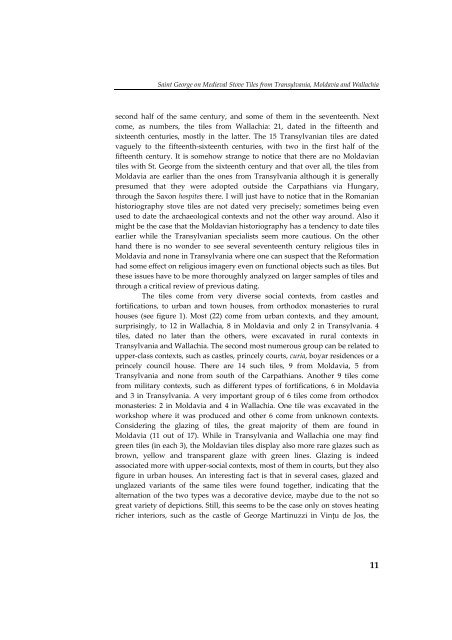Ana Maria Gruia - "Saint George on Medieval Stove - PATZINAKIA
Ana Maria Gruia - "Saint George on Medieval Stove - PATZINAKIA
Ana Maria Gruia - "Saint George on Medieval Stove - PATZINAKIA
You also want an ePaper? Increase the reach of your titles
YUMPU automatically turns print PDFs into web optimized ePapers that Google loves.
<str<strong>on</strong>g>Saint</str<strong>on</strong>g> <str<strong>on</strong>g>George</str<strong>on</strong>g> <strong>on</strong> <strong>Medieval</strong> <strong>Stove</strong> Tiles from Transylvania, Moldavia and Wallachia<br />
sec<strong>on</strong>d half of the same century, and some of them in the seventeenth. Next<br />
come, as numbers, the tiles from Wallachia: 21, dated in the fifteenth and<br />
sixteenth centuries, mostly in the latter. The 15 Transylvanian tiles are dated<br />
vaguely to the fifteenth-sixteenth centuries, with two in the first half of the<br />
fifteenth century. It is somehow strange to notice that there are no Moldavian<br />
tiles with St. <str<strong>on</strong>g>George</str<strong>on</strong>g> from the sixteenth century and that over all, the tiles from<br />
Moldavia are earlier than the <strong>on</strong>es from Transylvania although it is generally<br />
presumed that they were adopted outside the Carpathians via Hungary,<br />
through the Sax<strong>on</strong> hospites there. I will just have to notice that in the Romanian<br />
historiography stove tiles are not dated very precisely; sometimes being even<br />
used to date the archaeological c<strong>on</strong>texts and not the other way around. Also it<br />
might be the case that the Moldavian historiography has a tendency to date tiles<br />
earlier while the Transylvanian specialists seem more cautious. On the other<br />
hand there is no w<strong>on</strong>der to see several seventeenth century religious tiles in<br />
Moldavia and n<strong>on</strong>e in Transylvania where <strong>on</strong>e can suspect that the Reformati<strong>on</strong><br />
had some effect <strong>on</strong> religious imagery even <strong>on</strong> functi<strong>on</strong>al objects such as tiles. But<br />
these issues have to be more thoroughly analyzed <strong>on</strong> larger samples of tiles and<br />
through a critical review of previous dating.<br />
The tiles come from very diverse social c<strong>on</strong>texts, from castles and<br />
fortificati<strong>on</strong>s, to urban and town houses, from orthodox m<strong>on</strong>asteries to rural<br />
houses (see figure 1). Most (22) come from urban c<strong>on</strong>texts, and they amount,<br />
surprisingly, to 12 in Wallachia, 8 in Moldavia and <strong>on</strong>ly 2 in Transylvania. 4<br />
tiles, dated no later than the others, were excavated in rural c<strong>on</strong>texts in<br />
Transylvania and Wallachia. The sec<strong>on</strong>d most numerous group can be related to<br />
upper-class c<strong>on</strong>texts, such as castles, princely courts, curia, boyar residences or a<br />
princely council house. There are 14 such tiles, 9 from Moldavia, 5 from<br />
Transylvania and n<strong>on</strong>e from south of the Carpathians. Another 9 tiles come<br />
from military c<strong>on</strong>texts, such as different types of fortificati<strong>on</strong>s, 6 in Moldavia<br />
and 3 in Transylvania. A very important group of 6 tiles come from orthodox<br />
m<strong>on</strong>asteries: 2 in Moldavia and 4 in Wallachia. One tile was excavated in the<br />
workshop where it was produced and other 6 come from unknown c<strong>on</strong>texts.<br />
C<strong>on</strong>sidering the glazing of tiles, the great majority of them are found in<br />
Moldavia (11 out of 17). While in Transylvania and Wallachia <strong>on</strong>e may find<br />
green tiles (in each 3), the Moldavian tiles display also more rare glazes such as<br />
brown, yellow and transparent glaze with green lines. Glazing is indeed<br />
associated more with upper-social c<strong>on</strong>texts, most of them in courts, but they also<br />
figure in urban houses. An interesting fact is that in several cases, glazed and<br />
unglazed variants of the same tiles were found together, indicating that the<br />
alternati<strong>on</strong> of the two types was a decorative device, maybe due to the not so<br />
great variety of depicti<strong>on</strong>s. Still, this seems to be the case <strong>on</strong>ly <strong>on</strong> stoves heating<br />
richer interiors, such as the castle of <str<strong>on</strong>g>George</str<strong>on</strong>g> Martinuzzi in Vinţu de Jos, the<br />
11













